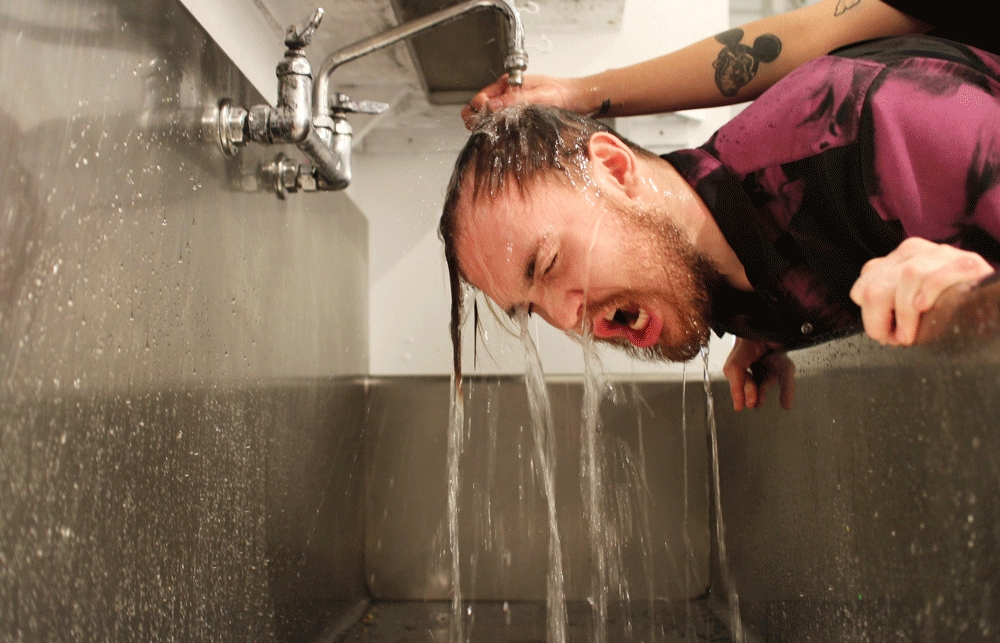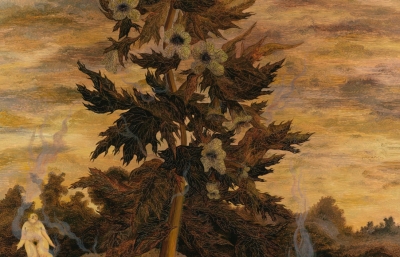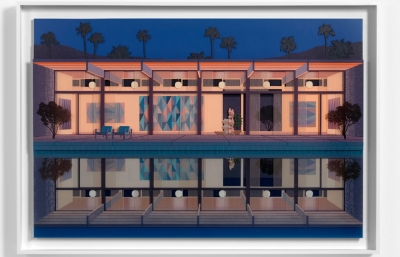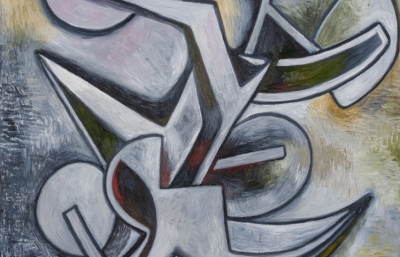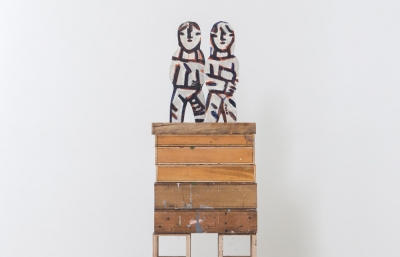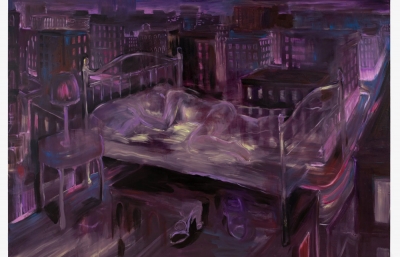Trey Abdella
Still in Detention
Interview and portrait by Sasha Bogojev
Tom and Jerry was created by two young cartoonists under the age of 30, convinced there was no need for dialogue if you provided non-stop action and visual humor. In a hundred different ways, at a hundred miles an hour, cat chases mouse, and mouse thinks of a hundred ways to outsmart him. High speed, and the proverbial hijinks that go with it. Trey Abdella grew up on Tom and Jerry, and in the end, outsmarted the doubters. He's a young guy who has arrived at record pace, and lets his art do the talking.
I first talked to Trey at the small studio booth set up at the New York Academy of Art, the place where he made works for solo shows in Rome and at Frieze NY, with T293 gallery. Quickly surpassing this setup like a certain mouse, he moved to his own home studio only a few days before NY went into lockdown. We got back in touch the night before the opening of his solo show in Berlin at König Galerie, and learned that he is currently working on an international museum debut.
This kind of extreme trajectory absolutely keeps pace with his utterly radical body of work, which, while pictorial at its core, skewers traditional figuration. From having zero interest or references to classical art, but grabbing a profusion of cartoon and movie references, to literally covering strokes by using the airbrush, his work exists in its own parallel universe. And while the concept of slapping up an actual object on a canvas might feel like cheating, the masterfully painted scenes are a confident middle finger to anyone making that assessment. Engrossed in blurring the lines between painting and sculpture, influenced by the aesthetics and ambiance of the ’50s and ’60s, and somehow recalibrated to view reality through a cinematic lens, Abdella finds a way to wallow gleefully through the moments of personal misery we all experience.

Sasha Bogojev: Describe your journey arriving to the art world.
Trey Abdella: Actually, what got me into art was that my parents grounded me as a punishment. I didn't want to do art, and I used to live for cartoons and stuff. But I did something that really pissed them off—I always did some shit or another. I was horrible as a kid. So, they were so pissed off they took away my TV, and I couldn't go on the computer, I couldn't go outside, and I was just like, "Oh what am I supposed to do?" Afterward, I would do chores and stuff and they gave me pencils and paper and said, "Why don't you just draw your own cartoons?" At first, I thought that was lame, but I started trying to draw my own and then I kind of got into it. I would just draw more, and I guess that's what I'm still doing.
How did you actually decide to go study in a formal way?
I remember I was in high school and had a meeting with this guidance counselor, and she asked if I really thought I could get into a college with what I was doing, actually asked me about my plans for life, and suggested that maybe I could get into community college. I was like, "Maybe?! What, you think I don’t have 300 dollars?" When she asked what I would be going to college for, off the top of my head, I just kind of spit out, "Art. I'm going to college for art." And I kind of did it to spite her a little bit. My friends even asked me later if I really wanted to go, and I was like, “Fuck you guys! Yeah, I wanna go to college!” Then one thing led to the other, and I sure wasn’t expecting that, a few years later, I would be teaching at one.

What was the school experience like?
I think I started when I was in high school preparing my portfolio, and I really got into it. Before I went to the School of Visual Arts, I went for a year to West Virginia University. I remember being there, really excited about it, and no one there except for my girlfriend at the time, who was actually into it. No one really gave a shit. People were basically just trying to get high and get a degree. My girlfriend then was, and still is, really talented, super good, and I was always trying to be on her level. At one point she said, "I'm going to go to this school in New York,” and asked if I was coming too. I just said: "Yeah, I'm going to go. Totally. Fuck yeah, I'm going to go to New York for school." Though I never fucking thought I’d do that.
But at SVA, I felt really far behind. A lot of people I went to school with had a more traditional upbringing. They went to art high schools, all those kinds of things, and I didn't know how to draw traditionally. I just drew shit at home. I felt like I needed to work ten times harder to catch up to everyone else, so, for five years, I didn't hang out with anyone. I didn't go out. I really didn't talk to anyone. I basically just buried myself in my studio and talked to, like, five people. I would try and work as little as I could, and paint as much as I could. I would paint until I passed out, and I'd be asleep on the floor sometimes.
It must have been hard being that far behind, and you must have felt like giving up. What stopped you?
Yeah, I was really close to giving up. I wanted to do way more things before I was a painter. But I was always very stubborn and kind of angry at myself, so I thought: "Fuck this! I can figure it out."
You mentioned before that most of your work, if not all of it, represents moments that you personally experienced or are metaphors for those experiences. Can you describe some of them, like the one with the sink and mirrors…
You mean the one… HOLY SHIT! God dammit! Fuck! Fuck! Fuck!... [Editor’s Note: At this point Trey realizes that some black paint that caused an accident earlier in the day has seeped into a finished painting that had been leaning on the side of the studio booth. He jumps out of his seat, grabs a piece of cloth and manically starts rubbing off the splatters. We take a break and continue once he assesses the damage.]

So, yeah, we were gonna talk about the experiences behind some of your works.
Well, the sink and mirrors one, for example, is from the bathroom at Art Basel. I remember I was just taking some time after seeing all the work there, and just kind of reexamining my life and thinking, "I'll fucking never be good enough to be here." Just like crying in the bathroom. I wasn't really crying, but I was just sort of depressed.
You seem pretty comfortable about sharing those personal moments with the world.
It’s fine, I think. For my last show, there were some super, super personal ones, but I don't mind it. Except for those times when people ask really specific things, and I give them the specific details, and they say, “Oh, is that what this is?!” Then I’m like, “Oh, you better back the fuck up!”
The narrative and characters in your work are really connected to you personally.
Oh yes, I think my work is autobiographical, so most of the paintings are about me in some way. Kind of like a weird diary entry from different days in my life.
Seeing your work and how it’s evolved in these past few months, I’m really impressed by the clever way you blend techniques and styles. What do you enjoy about mixing it up?
I'm really unsatisfied by just figuring something out, and that being it. I'm always trying to figure out a new way of approaching a painting or changing things up. I like playing with materials and different painting languages, finding things I can throw in to just surprise myself in fresh ways. I just find that really exciting. I wouldn’t say I have a super consistent process in which I plan out some of the ways to integrate different techniques. I try and plan them out as much as I can beforehand in the sketching process, but then sometimes, when I'm in the middle, I'll see something in the store that I would like to incorporate. For example, I found this dog collar at a shop and thought that I absolutely needed this particular collar with its printed name, Roxy. I needed that in my painting! Or I'll be at Michael’s Crafts, and see their bead selection for friendship bracelets, and go: "Oh my God, I really want a friendship bracelet. One that says “KILL ME!” I'm totally going to use that." Whenever I'm going anywhere I always look around for things that I can use somehow.

Another Year Older, Acrylic, glass, glitter, urethane, wig, rhinestone, fabric, collage, and birthday card on linen, 86” x 78”, 2020
Since you like incorporating all these techniques, do you have a favorite, something that, at the moment, is the most challenging or most satisfying?
I don't know if there’s a favorite, as they change from time to time. It's more that I'll plan things out beforehand, and try and think of how I'll make something new. It is not so much, "Oh, this, I'm super feeling this," but more along the lines that the image I make will dictate the materials which I will use and incorporate. When planning out my images, I try to think about how I'm going to really play around with the materials later on. I love glass. I've mixed in a lot of glass beads. I also love painting water. I'm a sucker for liquids of all kinds.
Liquids? Why is that?
It’s all around us! I feel I just drink so much water, and it’s everywhere. It is weird how water and liquids can represent so many different things—it’s tears, it's also what you're constantly drinking, like booze and all kinds of drinks, they're always there. I feel that, depending on how the water is shown, it can really be specific to the context of the situation. Wherever I go, I always have drinks, not always the same kind, but I always have something.
I’m curious to know how you prepare your work before approaching the canvas.
First, I sketch things out in my sketchbook, and I'll write ideas down constantly, doing a bunch of thumbnails and going through random bits. From there, I start planning things out in Photoshop and doing digital sketches. I go to libraries or bookstores and search through their image collections and things like that. I try and find pictures that I feel I could use, putting those together. Or I'll just go through my thousands of movie screenshots out and take pictures for reference, do that kind of thing. Then I just manipulate those for a while and follow that by making a couple of sketches. I usually make tons of sketches. I can have around six or seven going on at any one time on my computer. Then, out of six or seven, maybe one or two of them survive, and I just kind of sit with them for a while. Sometimes, I’ll really hate something, and the next day think, "That was stupid."
Back to the surprising mixture of styles and visuals that have really become your signature, I want to know more about why you feel compelled to have, for example, a realistically rendered fabric surface with a cartoonish face?
I think that so much very realistic art has been made, and I loved growing up on cartoons and things like that, so right now, with the internet, everything is just this conglomeration of all these different languages, and everything's kind of tied together in some way. So, I feel like my work should be the same. As far as it being this hybridization of all these different techniques, and other materials and things like that. To me, that's just the world we're living in.

You reference growing up on cartoons, but what are some other influences you remember? What are you obsessing over?
I remember just being really obsessed with Tom and Jerry, obviously. When I was a kid, I used to always watch that show because I had to get up at 4:00 a.m. for some reason. My dad would get up really early for work, so I would just be up, and it'd be the only thing that was on, so I would just constantly watch these shows every morning. The Looney Tunes, the older cartoons and such. I grew up on these, and the art in them was way better than what the newer ones have. I loved the slapstick humor and the art, the ways they animated those chaotic fight scenes, and those effects that they would use. I thought that was really interesting, and thought about how that could play into a more traditional painting sentence. Of course, I grew up with a lot of other things, like Goosebumps. So I try to bring all of these influences from my childhood back, and put them into this fine art scenario. As far as current influences, I spend so much of my time going to lots of art shows.
How did you transition from working out of a studio booth at the New York Academy to having your own home studio? Did that affect the work and pace of your practice?
At the Academy, as you saw, I was in this room and my paint was literally spilling off. I still haven't fixed that piece, actually. Anyways, I was really cramped, the hours were more limited, and it was hard for me to work on a large scale.
The whole experience was very nice and I really appreciate that the academy gave me space for a year, but when I got my own studio, I finally had more room and could work whenever I wanted. And it’s easier for me to work larger. At the Academy, I couldn't get my paintings as big as I wanted them. And if I did, I would do nothing else in the studio. I couldn't move, and that was a pain in the ass. But now I have more than enough room to make the work I want, including being able to work on sculpture.
What are some downsides to having a home studio?
Living in my studio has been actually killing me, like on a physical level. Mentally, I like being able to just work whenever I want, and work as much as I can. But then, health-wise, I use all of these really toxic materials like airbrush, epoxies, and resins. I sleep here, so that’s not the best situation. I have actually gone to the hospital and to doctors from the reactions I’ve had, like breathing problems, things like that. It's one of those things I can't escape. I’ll have my windows open and I also have a giant ventilator fan to help with air circulation, but sometimes I have to sleep with my respirator on. Plus, since I live here, I feel like I’ve started to hate my paintings!

Cutting You Off, Acrylic, glass, cotton, denim, fabric, wig, hot glue, fake leaves, thumbtack, and beads on linen, 100” x 50”, 2020
What do you mean?
I liked the separation—you go to the studio and you make plans that you’re going to get some work done, and then go home. Now, every morning, I wake up and I’ll think, “Oh my god, that fucking sucks.” You can't leave. I try to have people over, but not in a studio visit kind of way. I don't have anything in that apartment besides paintings that I'm working on. I literally bought a hundred dollars futon and have this cheap ass mattress.
Ah, so you really are living in a studio, and not working from home.
Yeah. So what I have to make it home are a bunch of weird creepy toys just laying around.
Since the work reflects your mood and experiences, did the whole lockdown experience and pandemic experience come through your work in any way?
I don't really think the pandemic has. I do think it's made me more introspective in my work, at least. I've been thinking a lot back to the past, especially my childhood, and things like that are in some of my more recent paintings… this kid squirting glue all over his desk, while being really frustrated and just stuck in detention, which is kind of what living in 2020 feels like.
Are you able to see any fun in the misery during this past half-year?
Yeah, for me, it's also been a great time. Like, it's been the worst time, but also, career wise, I've been doing better than ever. Making a lot of work, and also just being where I am at right now. It's just all happened during this particular time. So, it's just been weird, all of these things working out for me as the world goes to complete shit.
Trey Abdella’s solo show, Growing Pains, was on view at KÖNIG GALERIE, Berlin, this past fall // This interview was originally published in the Winter 2021 Quarterly

